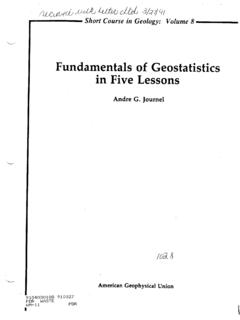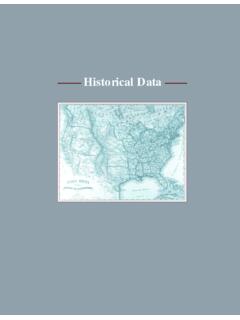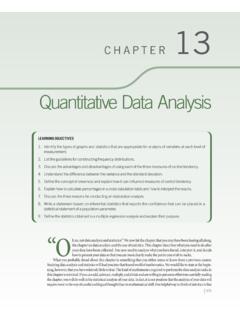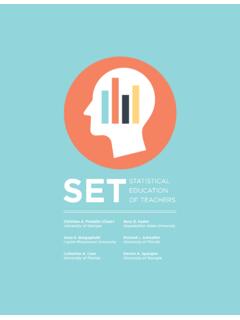Transcription of A Review of Basic Statistical Concepts
1 11A Review of Basic Statistical ConceptsThe record of a month s roulette playing at Monte Carlo can afford us material for discussing the foundations of knowledge. Karl PearsonI know too well that these arguments from probabilities are imposters, and unless great caution is observed in the use of them, they are apt to be deceptive. Plato (in Phaedo)IntroductionIt is hard to find two quotations from famous thinkers that reflect more divergent views of probability and statistics . The eminent statistician Karl Pearson (the guy who invented the correlation coefficient) was so enthralled with probability and statistics that he seems to have believed that understanding probability and statistics is a cornerstone of human under-standing. Pearson argued that Statistical methods can offer us deep insights into the nature of reality. The famous Greek philosopher Plato also had quite a bit to say about the nature of reality.
2 In contrast to Pearson, though, Plato was skeptical of the fuzzy logic of probabilities and central tenden-cies. From Plato s viewpoint, we should only trust what we can know with absolute certainty. Plato probably preferred deduction ( , If B then C) to induction (In my experience, bees seem to like flowers).Even Plato seemed to agree, though, that if we observe great caution, arguments from probabilities may be pretty useful. In contrast, some modern nonstatisticians might agree with what the first author s father, Bill Pelham, used to say about statistics and probability theory: Figures 2 INTERMEDIATE STATISTICScan t lie, but liars sure can figure. His hunch, and his fear, was that you can prove anything with statistics . To put this a little differently, a surpris-ing number of thoughtful, intelligent students are thumbs-down on statis-tics. In fact, some students only take statistics because they have to ( , to graduate with a major in psychology, to earn a second or third PhD).
3 If you fall into this category, our dream for you is that you enjoy this book so much that you will someday talk about the next time that you get to take or teach a statistics purpose of this first chapter, then, is to convince you that Karl Pearson s rosy view of statistics is closer to the truth than is Bill Pelham s jaded view. It is possible, though, that you fully agree with Pearson, but you just don t like memorizing all those formulas Pearson and company came up with. In that case, the purpose of this chapter is to serve as a quick refresher course that will make the rest of this book more useful. In either event, no part of this book requires you to memorize a lot of com-plex Statistical formulas. Instead, the approach emphasized here is heavily conceptual rather than heavily computational. The approach emphasized here is also hands-on. If you can count on your fingers, you can count your blessings because you are fully capable of doing at least some of the important calculations that lie at the very heart of statistics .
4 The hands-on approach of this book emphasizes logic over rote calculation, capital-izes on your knowledge of everyday events, and attempts to pique your innate curiosity with realistic research problems that can best be solved by understanding statistics . If you know whether there is any connection between rain and umbrellas, if you love or hate weather forecasters, and if you find games of chance interesting, we hope that you enjoy at least some of the demonstrations and data analysis activities that are contained in this we jump into a detailed discussion of statistics , however, we would like to briefly remind you that (a) statistics is a branch of mathe-matics and (b) statistics is its own very precise language. This is very fitting because we can trace numbers and, ultimately, statistics back to the begin-ning of human language and thus to the beginning of human written history.
5 To appreciate fully the power and elegance of statistics , we need to go back to the ancient Middle Numbers and Language Revolutionized Human HistoryAbout 5,000 years ago, once human beings had began to master agricul-ture, live in large city states, and make deals with one another, an unknown Sumerian trader or traders invented the cuneiform writing system to keep track of economic transactions. Because we live in a world surrounded by numbers and written language, it is difficult for us Chapter 1 A Review of Basic Statistical Concepts 3to appreciate how ingenious it was for someone to realize that writing things down solves a myriad of social and economic problems. When Basam and Gabor got into their semimonthly fistfight about whether Gabor owed Basam five more or six more geese to pay for a newly weaned goat, our pet theory is that it was an exasperated neighbor who finally got sick of all the fighting and thus proposed the cuneiform writ-ing system.
6 The cuneiform system involved making marks with a stylus in wet clay that was then dried and fired as a permanent record of eco-nomic transactions. This system initially focused almost exclusively on who had traded what with whom and, most important, in what quan-tity. Thus, some Sumerian traders made the impressive leap of impress-ing important things in clay. This early cuneiform writing system was about as sophisticated as the scribbles of your 4-year-old niece, but it quickly caught on because it was way better than spoken language example, it apparently wasn t too long before the great-great- great-grandchild of that original irate neighbor got a fantastically bril-liant idea. Instead of drawing a stylized duck, duck, duck, duck to repre-sent four ducks, this person realized that four-ness itself (like two-ness and thirty-seven-ness) was a concept .
7 He or she thus created abstract characters for numbers that saved ancient Sumerians a lot of clay. We won t insult you by belaboring how much easier it is to write and verify the cuneiform version of 17 goats than to write goat, goat, goat, goat, goat, goat, goat, goat, goat, goat, goat, goat, goat, goat, goat, goat .. oh yeah .. goat, but we can summarize a few thousand years of human technological and scientific development by reminding you that incredi-bly useful Concepts such as zero, fractions, p (pi), and logarithms, which make possible great things such as penicillin, the Sistine Chapel, and iPhones, would have never come about were it not for the development of abstract numbers and is probably a bit more fascinating to textbook authors than to text-book readers to recount in great detail what happened over the course of the next 5,000 years, but suffice it to say that written language, numbers, and mathematics revolutionized and sometimes limited human scien-tific and technological development.
8 For example, one of the biggest ruts that brilliant human beings ever got stuck into has to do with numbers. If you have ever given much thought to Roman numerals, it may have dawned on you that they are an inefficient pain in the butt. Who thought it was a great idea to represent 1,000 as M while representing 18 as XVIII? And why the big emphasis on five (V, that is) in a base-10 number system? The short answer to these questions is that whoever formalized Roman numbers got a little too obsessed with counting on his or her fingers and never fully got over it. For example, we hope it s obvious that the Roman numerals I and II are stand-ins for human fingers. It is probably less obvious 4 INTERMEDIATE statistics that the Roman V ( 5 ) is a stand-in for the V that is made by your thumb and first finger when you hold up a single hand and tilt it outward a bit (sort of the way you would to give someone a high five ).
9 If you do this with both of your hands and move your thumbs together until they cross in front of you, you ll see that the X in Roman numerals is, essen-tially, V + V. Once you re done making shadow puppets, we d like to tell you that, as it turns out, there are some major drawbacks to Roman num-bers because the Roman system does not perfectly preserve place (the way we write numbers in the ones column, the tens column, the hundreds column, etc.). If you try to do subtraction, long division, or any other procedure that requires carrying in Roman numerals, you quickly run into seri-ous problems, problems that, according to at least some scholars, sharply limited the development of mathematics and perhaps technol-ogy in ancient Rome. We can certainly say with great confidence that, labels for popes and Super Bowls notwithstanding, there is a good rea-son why Roman numerals have fallen by the wayside in favor of the nearly universal use of the familiar Arabic base-10 numbers.
10 In our familiar system of representing numbers, a 5-digit number can never be smaller than a 1-digit number because a numeral s position is even more important than its shape. A bank in New Zealand (NZ) got a painful reminder of this fact in May 2009 when it accidentally deposited $10,000, (yes, ten million) NZ dollars rather than $10, (ten thousand) NZ dollars in the account of a couple who had applied for an overdraft. The couple quickly fled the country with the money (all three extra zeros of it).1 To everyone but the unscrupulous couple, this mistake may seem tragic, but we can assure you that bank errors of this kind would be more common, rather than less common, if we still had to rely on Roman you are wondering how we got from ancient Sumer to modern New Zealand or why the main point of this foray into numbers is that life as we know and love it depends heavily on numbers, mathematics, and even statistics .

















